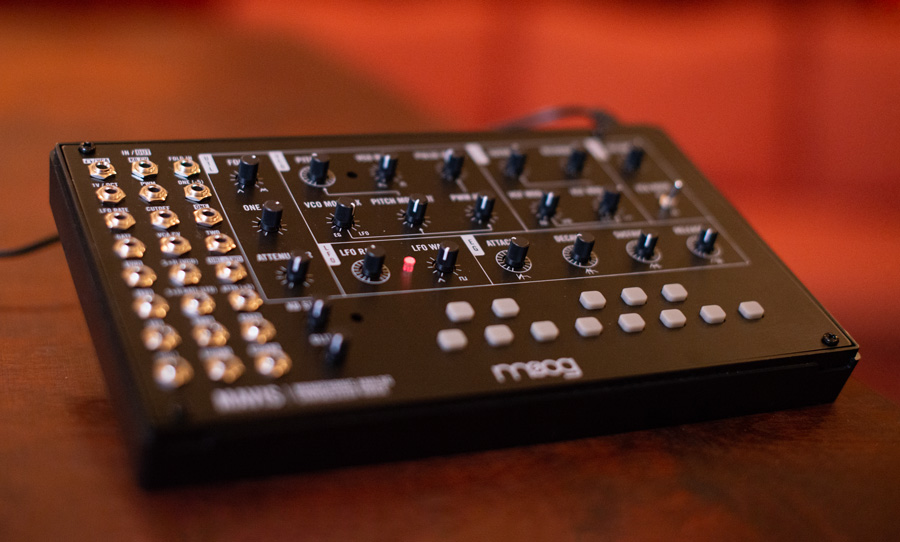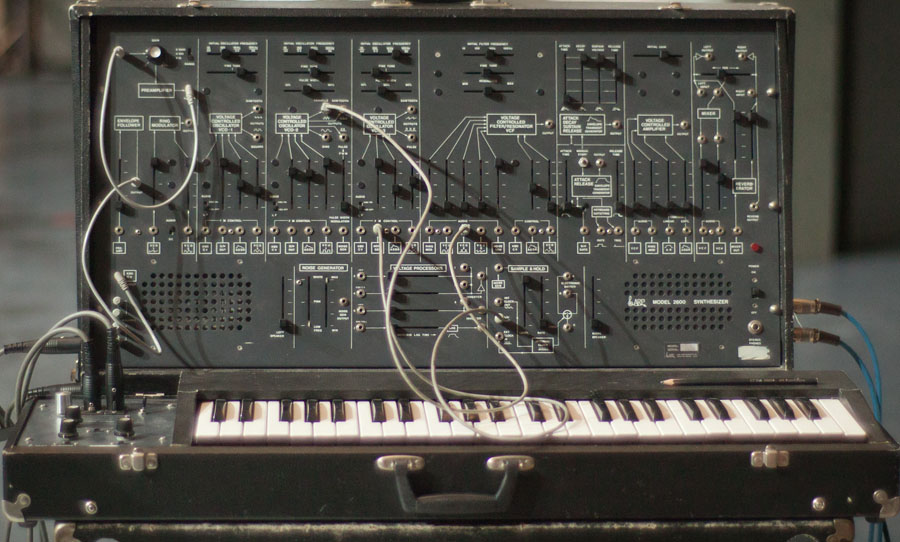Think about modular synthesis for a minute. What images are conjured up for you? Refrigerator-sized monoliths in a room that looks a bit like mission control from golden age of NASA?
Dan Goldstein from Cherry Audio thought about this style of synthesis differently, recreating the open-ended wonder of modular synthesis and bringing it into the software world. In our recent chat, Goldstein shed light on his company’s development, sources of inspiration and the team that assembled to make the software modular dream a reality.
Inspired by the vintage, but made for a new millenium, Cherry Audio has brought the world of modular synthesis within reach for new generation fans. Read on for an inspirational conversation with CTO, Dan Goldstein.
ENMORE AUDIO: Voltage Modular has been around for a little while now. Tell us a bit about how the company got started?
DAN GOLDSTEIN: We’re celebrating the one-year anniversary of Voltage Modular’s release right now! It’s incredible to watch the platform grow and evolve in so many exciting directions. When we launched Voltage Modular a year ago, there were fewer than 100 modules available for the platform. Today, there are close to 400 modules available, and the platform keeps on growing, with new developers signing on every week.
Voltage Modular began as an idea that I had in 2004, to create a software modular platform that was infinitely expandable, based loosely on my Synthesizers.com modular system. I built a prototype of the platform and was very excited about its potential, but modular synthesis was much more of a niche field 15 years ago, and the project sat in a folder on my hard drive for many years.
In 2017, as Eurorack modular systems became massively popular, I realized that musicians were really passionate about assembling their own custom systems based on modules from many different companies. I realized that the key to success for a software modular was to make it an entirely open platform, with easy tools for developers to create and distribute their own modules.
I assembled a team of talented programmers, artists, synthesists, and sound designers, and we formed Cherry Audio. We immediately set to work building our dream modular synthesis platform. Our goal was to create a platform that sounded great, looked great, was easy to use, and was infinitely expandable. We refused to cut corners, and it took a year to build, but today Voltage Modular is everything we hoped it would be.
ENMORE AUDIO: Tell us about the space you create in. Is it all just computers? Or do you tinker with hardware too?
DAN GOLDSTEIN: We’re huge vintage synthesizer fans at Cherry Audio. Between us, we’ve got Moogs, Prophets, ARPs, and KORGs, plus piles of modular equipment. My personal modular setup consists of Synthesizers.com modules, Roland System 100 modules, an Aries Modular setup, and an original 1969 Moog Modular.
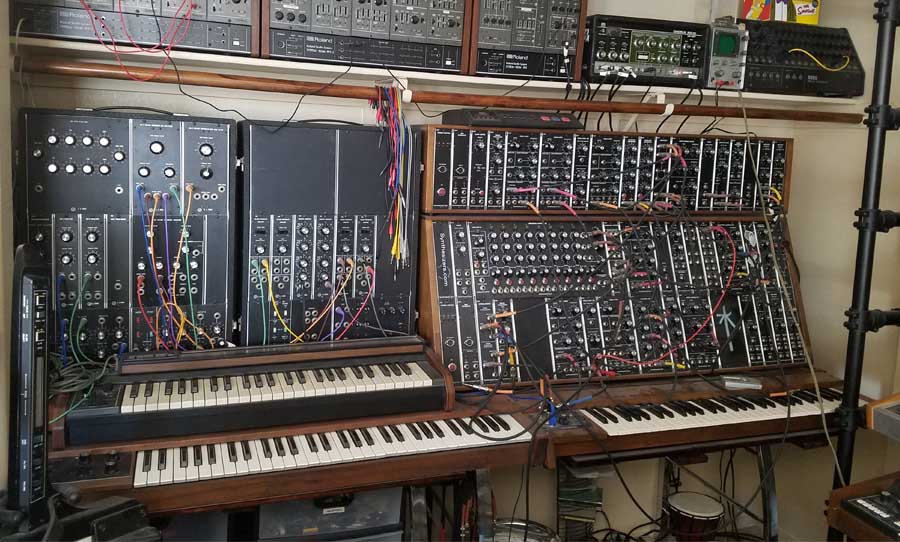
We’ve run our synths through oscilloscopes, taken detailed signal measurements, and done endless A/B testing to ensure that our modules sound great. We worked very hard to nail the sound of our Vintage Oscillator, Ladder Filter, MS and TB filters and oscillators, Polymoog-style resonator section, and other vintage synth-inspired modules.
Because we’re obsessed with hardware synths, we know how a virtual modular should work, how it should sound, and how it should feel.
ENMORE AUDIO: Computers have evolved considerably since you first imagined Voltage Modular. Has that affected your process?
DAN GOLDSTEIN: To do modular synthesis properly, every module has to process every sample individually, so feedback loops and frequency modulation will be responsive and accurate. In 2004, I was impressed that my prototype was able to do flawless real-time modular synthesis processing, with very low latency.
Today, we’re able to create high-quality, oversampled filters and alias-free oscillators without scratching the CPU. Voltage Modular can take advantage of multiple processors, and with a fast computer, massive modular patches can be created loaded with oscillator and filters, complex effects, hosted plug-ins, and complex modulation routings.
ENMORE AUDIO: What different skill sets do the team members at Cherry Audio bring to the table?
DAN GOLDSTEIN: Voltage Modular would never have happened without the incredible team that we have at Cherry Audio. I’ve been writing professional music software for over 20 years, and so have the other programmers on my team.
Cherry Audio’s main module designer, Mitchell, literally wrote the book on synthesizer programming after years of writing for Keyboard Magazine, and toured the United States with Survivor and Berlin. Our presets were programmed by my friend James, who also creates presets for Dave Smith Instruments.
Since we’re all vintage synth collectors, our standards are impossibly high. Simply put, we love this stuff, and if we were going to build this software, we wanted to do it right.
ENMORE AUDIO: What are some of the challenges in bringing modular synthesis ‘in the box’?
DAN GOLDSTEIN: With any software synthesizer, you want to reach out and turn the knobs, but the screen is in the way. When you add in virtual cables, things can get crowded. We wanted to completely replicate the experience of using a hardware modular synthesizer, but we also wanted to make sure we took full advantage of the many advantages of using a computer.
In the end, we did both. We added macro knobs in the Performance Panel, and these can be mapped to any number of controls in a patch, so turning a single macro knob can introduce all sorts of complex changes to a patch. Our virtual cables can be optionally transparent, and can optionally move out of the way of your mouse cursor.
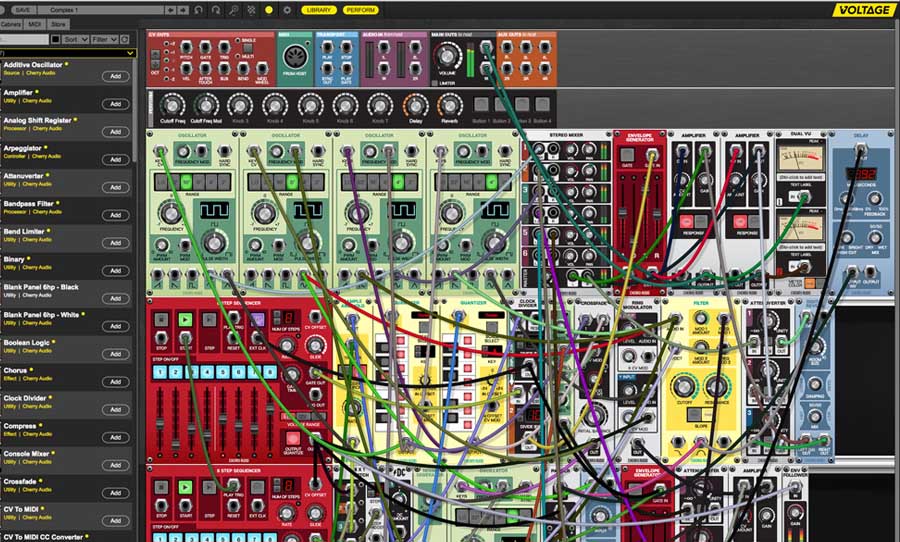
Every single jack – audio, MIDI, and polyphonic jacks – is actually 6 jacks, allowing multiple cables to be plugged in the same jack. Individual modules or entire cabinets can be instantly duplicated. In addition to standard instrument presets, every individual module can store its own presets, and entire cabinets can be saved into the cabinet library for immediate recall. Every knob, slider, switch and button can be instantly mapped to MIDI, and can also be mapped to keys on your typing keyboard.
There’s even a built-in musical typing keyboard, so you can work with modular patches on-the-go, without a MIDI controller.
Finally, Voltage Modular can itself host VST, VST3, and AU plug-ins (using the Plug-In Host and Mini Plug-In Host modules, available in our Core package), and plug-in parameters can be controlled by voltage sources such as LFOs and envelope generators, so the possibilities for creating beautiful, complex patches are truly endless.
The plug-in hosting capabilities, combined with the MIDI Input and MIDI Output modules, even allow for complex interactions with hardware modular synthesizers, both via MIDI and via products like Silent Way.
By embracing the flexible nature of the computer, while working hard to ensure the experience of using Voltage Modular is as close to the hardware experience as possible, we believe we’ve combined the best aspects of both to create a truly superior user interface.
ENMORE AUDIO: How do you make an open-ended process like modular synthesis streamlined for use within a DAW environment?
DAN GOLDSTEIN: Most virtual instruments have a fixed number of knobs and switches, making it easy to automate parameters. With an entirely open-ended platform, this at first seemed like a far more daunting problem.
In the end, we put our heads together and created a system that provides the ultimate in flexibility. First, every control can be MIDI-mapped, simply by right-clicking on it, selecting the MIDI Learn option, and moving a control on your MIDI device. In the MIDI tab, every MIDI mapping can be range-limited and even reversed, so that turning a hardware knob up will cause the software knob to turn down.
Every control can also be assigned to 128 different automation slots, so automating parameters with your DAW is as easy as choosing which parameters are automatable, and then drawing in or recording automation in your DAW. Finally, every control can be assigned to a macro knob, with the same ability to range-limit and even reverse the mappings, and the macro knobs themselves can be controlled by MIDI and DAW automation in the same manor.
Voltage Modular is available in every standard plug-in format, including VST, VST3, AU, and AAX, plus it runs stand-alone, so you can use it in any environment that works best for you. There are 4 audio inputs and 8 audio outputs, so getting signals from your DAW into Voltage Modular and back out to your DAW again is a snap.
Voltage Modular is available as both a virtual instrument plug-in and an effects plug-in, and using it as an effect to process guitars, vocals, and other audio tracks can lead to some incredible sonic discoveries.
ENMORE AUDIO: What drew you to the world of software synthesis? Have you considered, or even designed hardware synths?
DAN GOLDSTEIN: I’ve been collecting, restoring, and repairing vintage synthesizers for over 25 years, and I get as excited about a new synthesizer today as I did when I was a teenager. When the first affordable DAWs appeared, I knew I wanted to be a part of that world, and soon afterwards I was working for Sonic Foundry, building professional audio applications.
When virtual synthesizers first became available, the possibilities were immediately very exciting. And of course the technology has grown and evolved as computers have gotten faster and more capable. It’s an exciting industry, and it’s an exciting time to be a part of it.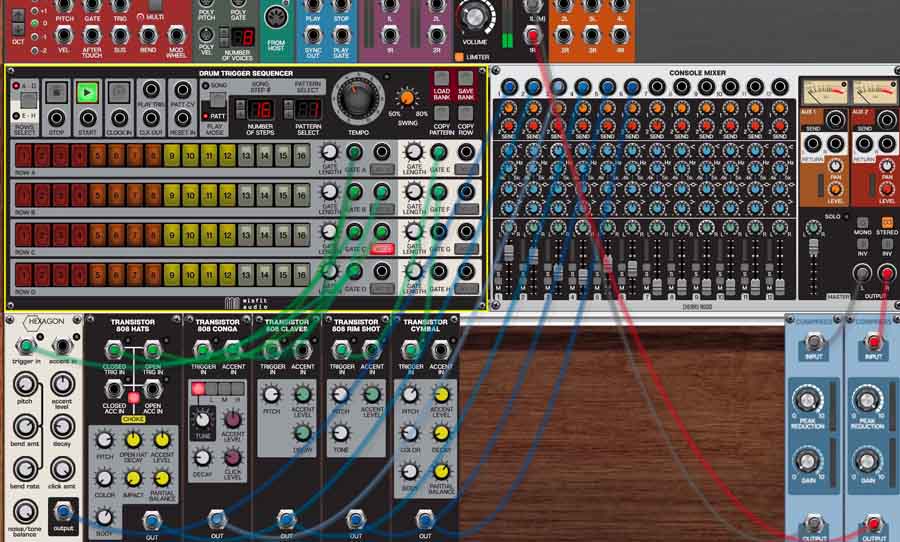
I’ve repaired countless vintage synthesizers, and as a result I have a deep understanding of how they behave and what makes them tick. As an expert in synthesis, I know how thrilling it can be to create a new and exciting sound, to wire modules together to bring a new timbre out of your imagination and into reality.
In the end, hardware modular synthesizers are complex, bulky, and very expensive. I wanted to make this technology available to everybody, and in the end, I simply couldn’t be more proud of what we’ve built.
ENMORE AUDIO: What are your plans for the future?
DAN GOLDSTEIN: There’s some amazing technology that’s gone into Voltage Modular, from our innovative DSP, to our custom module server, to our incredibly unique module development tools. We’ve got ideas to bring these tools and technologies beyond the world of modular synthesis, to create new and interesting plug-ins.
Meanwhile, the Voltage Modular eco-system continues to grow and mature, and there are some truly amazing new modules in development. The future is indeed very bright!
For more information about the Voltage Modular platform, visit Cherry Audio.

